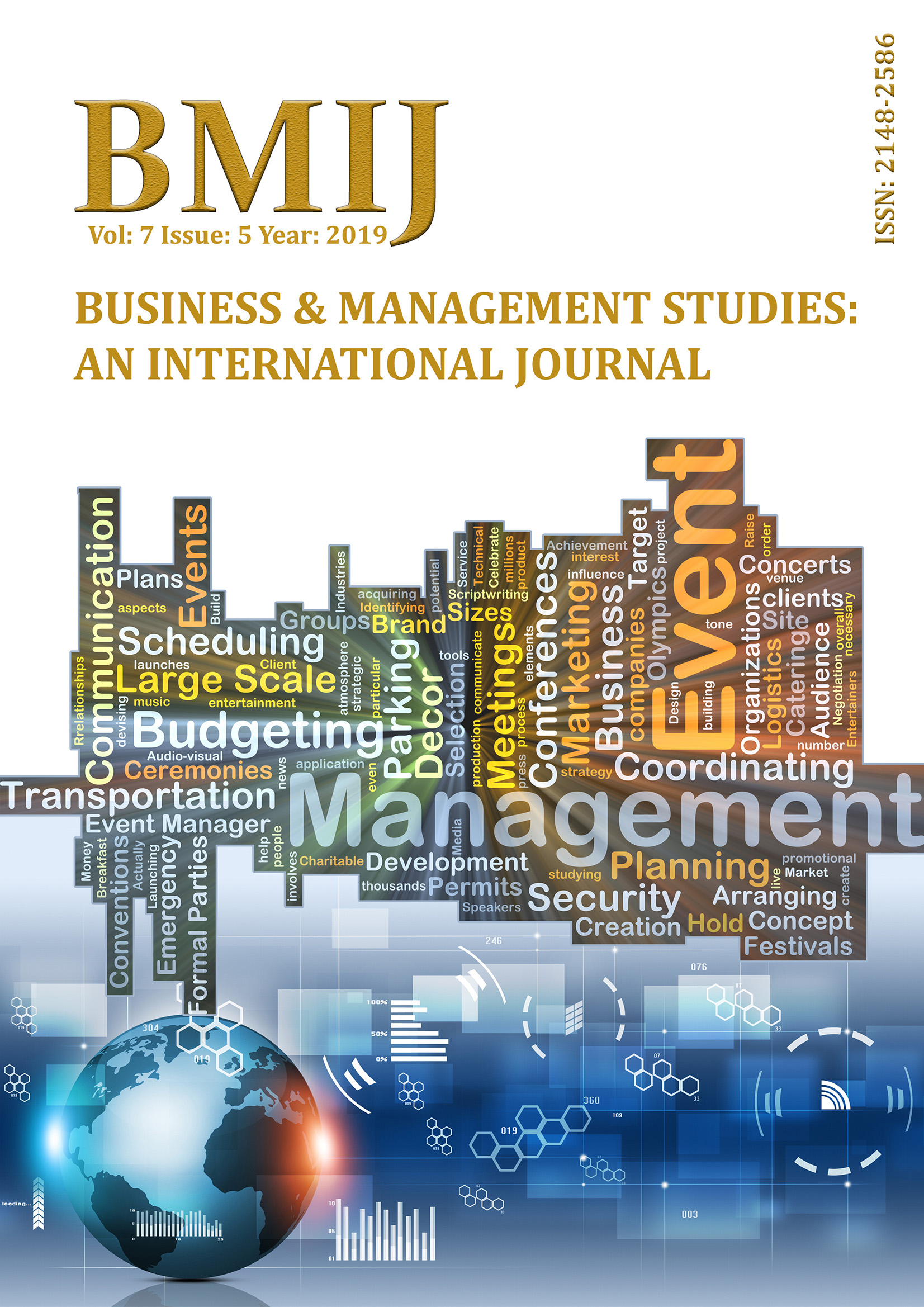OTEL İŞLETMELERİNDE ÇALIŞANLARIN KURUMSAL PRESTİJ ALGILARININ SERGİLEDİKLERİ DUYGUSAL EMEK ÜZERİNE ETKİLERİ: ELAZIĞ İLİNDE BİR ARAŞTIRMA

Yayınlanmış 25.12.2019
Anahtar Kelimeler
- Tourism, Corporate Prestige, Emotional Labour
- Otel İşletmeleri, Kurumsal Prestij, Duygusal Emek
Nasıl Atıf Yapılır
Nasıl Atıf Yapılır
Öz
Otel işletmeleri gibi emek-yoğun üretim yapan hizmet işletmelerinde, çalışanlar tarafından sergilenen duygusal emeğin rolü, teknoloji-yoğun işletmelere kıyasla daha fazla önem taşımaktadır. Literatürde çeşitli değişkenler ile duygusal emek arasındaki ilişki ve etki durumlarını test etmeye yönelik araştırmalar bulunmaktadır. Fakat algılanan kurumsal prestijin çalışanlar tarafından sergilenen duygusal emek üzerindeki etkilerinin incelendiği herhangi bir çalışmaya rastlanmaması bu araştırmanın çıkış noktasını; toplanan veriler neticesinde kurumsal prestij algısının duygusal emeğin yüzeysel, samimi ve derin davranış boyutları üzerindeki etki durumlarının ayrı ayrı test edilerek literatüre yeni bulgular sunulması ise araştırmanın temel amacını oluşturmaktadır. Bu amaç doğrultusunda, Elâzığ ilinde faaliyette bulunan turizm işletme belgeli otellerde çalışan personel ile yüz yüze anket yöntemi kullanılarak bir araştırma yapılmıştır. Araştırmadan elde edilen verilerin güvenilirlik ve geçerlilik durumları SPSS programında analiz edilmiştir. Daha sonra, algılanan kurumsal prestijin çalışanların sergiledikleri duygusal emek üzerine etkilerini test etmek üzere, AMOS programında yapısal eşitlik modeli analizi yapılmıştır. Ulaşılan bulgulara göre; algılanan kurumsal prestijin duygusal emeğin yüzeysel davranış boyutunu negatif yönde ve anlamlı düzeyde, samimi davranış ve derin davranış boyutlarını ise pozitif yönde ve anlamlı düzeyde etkilediği tespit edilmiştir.
Referanslar
- Ashforth, B., E., Humphrey R.H. (1993). Emotional Labor in Service Roles: The Influence of Identity, Academy of Management Review, 18 (1), 88-115.
- Aydoğan, E., ve Deniz, G. (2018). İşgörenlerin Dışsal Prestij ve Örgütsel Destek Algısının Pozitif Örgütsel Çıktılar Üzerindeki Etkisi, Butik Otel İşletmelerinde Bir Araştırma, Hacettepe Üniversitesi İktisadi ve İdari Bilimler Fakültesi Dergisi, 36(1), 17-37.
- Ardahan, F., ve Mert, M. (2013). Impacts of Outdoor Activities, Demografic Variables and Emotional Intelligence on Life Satisfaction: An Econometric Application of a Case in Turkey, Social Idicators Research, 113(3), 887-901.
- Bardakoğlu Ö. ve Akgündüz, Y. (2016). Otel Çalışanlarının Örgütsel Prestij ve Psikolojik Güçlendirme Algılarının İşbirliği Davranışlara Etkisi, Uluslararası İktisat ve İşletme Dergisi, 12(30), ss.145-158.
- Başbuğ, G., Ballı, E. ve Oktuğ, Z. (2010). Duygusal Emeğin İş Memnuniyetine Etkisi: Çağrı Merkezi Çalışanlarına Yönelik Bir Çalışma. Sosyal Siyaset Konferansları Dergisi, 58, 253-274.
- Büyüköztürk, Şener (2006). Sosyal Bilimleri İçin Veri Analizi El Kitabı: İstatistik, Araştırma Deseni-SPSS Uygulamaları ve Yorum, Pegema Yayıncılık, Ankara.
- Carmeli, A., & Freund, A. (2002). The Relationship between Work and Workplace Attitudes and Percieved External Prestige, Corporate Reputation Review, 5(1), pp 51-68.
- Chu, K., H. & Murrmann, S.K. (2006). Development and Validation of the Hospitality Emotional Labor Scale. Journal of Hospitality & Tourism Research, 27(6), 1181-1191.
- Dutton, J.E., Dukerich, J.M. & Harquail, C.V. (1994). Organizational Image and Member Identification, Administrative Science Quarterly, 39(2), pp.239-263.
- Ekman, P. (1971). Universal and Cultural Differences in Facial Expressions of Emotions, Nebrasca Symposium on Motivation, pp.869-885.
- Eren, D. ve Demirel, N. (2018). Duygusal Emek Faktörünün Hizmet Kalitesine Etkisi: Nevşehirdeki Dört ve Beş Yıldızlı Otellere Yönelik Bir Araştırma, Iğdır Üniversitesi Sosyal Bilimler Dergisi, 14, 310-334.
- Eroğlu, E. (2010). Örgütsel Iletişimin Işgörenlerin Duygu Gösterimlerinin Yönetimine Oln Etkisi, Selçuk Üniversitesi İletişim Fakültesi Akademik Dergisi, 6(3), 18-33.
- Grandey, A.A. (2000). Emotion Regulation in the Workplace: A New Way to Conceptualize Emotional Labor. Journal of Occupational Health Psychology, 5(1), 95–110.
- Gross, J.J. (1998). The Emerging Field of Emotion Regulation: An Integrative Review, Review of General Psychology, 2(3), pp.271-299.
- Gündüz, İ. (2017). Duygusal Emek Faktörünün Hizmet Kalitesine Etkisi: Kuşadası’ndaki Dört ve Beş Yıldızlı Otellere Yönelik Bir Araştırma, Adnan Menders Üniversitesi Sosyal Bilimler Enstitüsü Turizm İşletmeciliği Anabilim Dalı, Yayınlanmamış Yüksek Lisans Tezi.
- Hasan, M. & Hussain, M. (2015). Role of Percieved External Prestige and Organizational Justice in Organizational Identification, Europan Online Journal of Natural and Social Science, 4(3), pp.611-625.
- Hochschild, A.R. (1983). The Managed Heart: Commercialization of Human Feeling, , University of California Press: California.
- Hochschild, A.R. (2012). The Managed Heart: Commercialization of Human Feeling Updated with a New Preface, University of California Press, Third Edition: California.
- Kline, R. B. (1998). Principles and Practice of Structural Equation Modeling, New York: The Guilford Press.
- Mael, F., & Ashforth, B.E. (1992). Alumni and Their Alma Matter: A Partial Test of the Reformulated Model of Organizational Identification, Journal of Organizational Behaviour, Vol: 13, pp103-123.
- March, J.G. & Simon, H.A. (1958). Organizations, John Wiley&Sons, Inc.
- Morris J.A. & Feldman D.C. (1996). The Dimensions, Antecedents and Consequences of Emotional Labor. Academy of Management Review, 21, 986–1010.
- Schermelleh-Engel, K., Moosbrugger, H. & Muller, H. (2003). Evaluating the Fit of Structural Equation Models: Tests of Significance and Descriptive Goodness-of-Fit Measures, Methods of Psychological Research Online, 8(2), pp.23-74.
- Smidts, A., Pruyn, A.T.H. & Van Riel C.B.M. (2001). The Impact of Employee Communication and Percieved External Prestige on Organizational Idendification, Academy of Management Journal, 49(5), pp. 1051-1062.
- Sulentic, T.S., Znidar, K. & Pavicic, J. (2017). The Key Determinants of Percieved External Prestige (PEP) –Qualitative Research Approach, Management, 22(1), pp.49-84.
- Şimşek, Ö. F. (2007). Yapısal Eşitlik Modellemesine Giriş: Temel İlkeler ve LISREL Uygulamaları, Ankara: Ekinoks Yayınları.
- Tak, B. ve Çiftçioğlu, A. (2009). Algılanan Örgütsel Prestij ile Örgütsel Bağlılık ve Örgütsel Özdeşleşme Arasındaki İlişkilerin İncelenmesine Yönelik Bir Araştırma, Akdeniz İ.İ.B.F. Dergisi, 18, 100-116.
- Tavşancıl, E. (2006). Tutumların Ölçülmesi ve SPSS ile Veri Analizi, Nobel Yayın Dağıtım, Ankara.
- Tezbaşaran, A. (1996). Likert Tipi Ölçek Hazırlama Klavuzu, (E-Kitap) https://www.academia.edu/1288035/Likert_Tipi_%C3%96l%C3%A7ek_Haz%C4%B1rlama_K%C4%B1lavuzu (Erişim: 05.11.2019).
- World Tourism Organization (2016), UNWTO 2015 Report
- Yazgan, E., ve Zerey, Y. (2003). İşletme İstatistiği, İstanbul: İstanbul Bilgi Üniversitesi.
- Yazıcıoğlu Y., ve Erdoğan, S. (2004). “Spss Uygulamalı Bilimsel Araştırma Yöntemleri”, Detay Yayıncılık, Ankara.
- https://elazig.ktb.gov.tr/TR-187342/oteller.html (Erişim: 14.05.2019).



